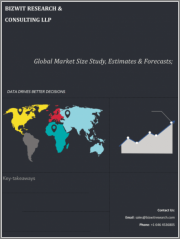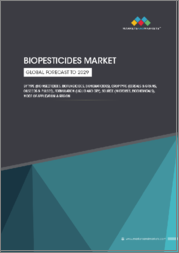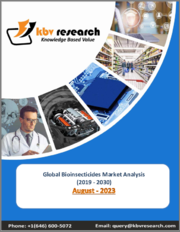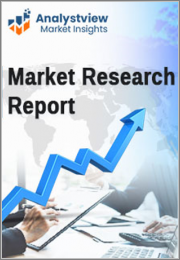
|
시장보고서
상품코드
1303525
세계의 바이오 살충제 시장 규모 조사 및 예측 : 유형별, 생물체별, 적용 모드별, 작물 유형별, 지역별 분석(2023-2030년)Global Bioinsecticides Market Size study & Forecast, by Type, by Organism, by Mode of Application, by Crop Type and Regional Analysis, 2023-2030 |
||||||
바이오 살충제는 식물, 박테리아, 곰팡이 및 기타 미생물과 같은 천연 자원에서 추출한 살충제의 일종입니다. 농업, 임업, 공중 보건에서 해충을 방제하는 데 사용됩니다. 합성 살충제와 달리 바이오 살충제는 비표적 생물과 환경에 미치는 영향을 최소화할 수 있습니다. 또한 특정 곤충 종이나 생활 단계만을 대상으로 하기 때문에 작용이 더 특이적인 경우가 많습니다. 따라서 종합적 해충관리(IPM) 프로그램에서는 귀중한 도구가 될 수 있습니다.
바이오 살충제의 예로는 특정 곤충에 유독한 단백질을 생산하는 세균인 Bacillus thuringiensis(Bt)와 님 나무에서 추출해 살충 효과가 있는 님 오일 등이 있습니다. 다른 예로는 spinosad, Beauveria bassiana, Metarhizium anisopliae 등이 있습니다. 해충의 부활, 종합적 해충 관리(IPM) 대책 증가, 유기농 식품에 대한 수용 확대, 정부 기관의 인식 제고, 침입 해충의 공격으로 인한 막대한 농작물 손실 등의 주요 요인은 예측 기간 동안 시장에 유리한 수요를 창출할 것으로 예상됩니다.
또한, 침입 해충의 공격으로 인한 작물 손실 증가는 바이오 살충제에 대한 유리한 수요를 창출할 것으로 예상되며, 2021년 유엔기구에 따르면 해충은 현재 세계 작물 생산량의 40% 이상의 손실을 초래하고 있으며 식물 질병은 매년 2,200억 달러 이상의 세계 경제에 피해를 입히고 있습니다. 생물다양성 손실의 주요 원인인 외래 해충은 매년 각국에 최소 700억 달러의 손실을 입히고 있습니다. 또한, 바이오 방제 종자 처리 솔루션의 높은 성장은 예측 기간 동안 시장에 유리한 기회를 창출할 것으로 예상됩니다. 그러나 바이오 살충제의 유통기한이 짧기 때문에 2023-2030년의 예측 기간 동안 시장 성장을 저해할 것으로 보입니다.
세계의 바이오 살충제 시장 조사에서 고려된 주요 지역은 아시아태평양, 북미, 유럽, 라틴아메리카, 중동 및 아프리카입니다. 북미는 과일 및 채소의 최대 잔류 기준(MRL)에 대한 소비자의 인식이 높아짐에 따라 2022년 시장을 주도했습니다. 그 결과, 소비자들은 잔류물이 없는 과일 및 채소를 선호하고 있으며, 이 지역의 생산자들은 바이오 살충제에 대한 수요가 증가하고 있습니다. 아시아태평양은 개인의 가처분 소득 증가, 공급망 관계자의 생산량 증가에 대한 관심 증가, 작물 품질에 대한 관심 증가, R&D 역량에 대한 지출 급증 등의 요인으로 인해 예측 기간 동안 큰 성장을 보일 것으로 예상됩니다.
이 조사의 목적은 최근 몇 년간 다양한 부문과 국가 시장 규모를 파악하고 향후 몇 년간 시장 규모를 예측하는 것입니다. 이 보고서는 조사 대상 국가의 산업의 질적/양적 측면을 모두 포함하도록 설계되었습니다.
또한 시장의 미래 성장을 규정하는 촉진요인과 과제 등 중요한 측면에 대한 자세한 정보도 제공합니다. 또한, 주요 기업의 경쟁 환경과 시장 상황에 대한 상세한 분석과 함께 이해관계자들이 투자할 수 있는 미시적 시장에서의 잠재적 기회에 대해서도 다루었습니다.
목차
제1장 주요 요약
- 시장 현황
- 세계 시장·부문별 시장 추산·예측, 2020-2030년
- 바이오 살충제 시장 : 지역별, 2020-2030년
- 바이오 살충제 시장 : 유형별, 2020-2030년
- 바이오 살충제 시장 : 생물별, 2020-2030년
- 바이오 살충제 시장 : 적용 모드별, 2020-2030년
- 바이오 살충제 시장 : 작물 유형별, 2020-2030년
- 주요 동향
- 조사 방법
- 조사의 전제조건
제2장 세계의 바이오 살충제 시장 정의와 범위
- 조사 목적
- 시장 정의와 범위
- 산업 발전
- 조사 범위
- 조사 대상년도
- 통화 환산율
제3장 세계의 바이오 살충제 시장 역학
- 바이오 살충제 시장 영향 분석(2020-2030년)
- 시장 성장 촉진요인
- 시장이 해결해야 할 과제
- 시장 기회
제4장 세계의 바이오 살충제 시장 산업 분석
- Porter's Five Forces 모델
- 공급 기업의 교섭력
- 바이어의 교섭력
- 신규 진출업체의 위협
- 대체품의 위협
- 경쟁 기업간 경쟁 관계
- Porter's Five Forces의 영향 분석
- PEST 분석
- 정치
- 경제
- 사회
- 기술
- 환경
- 법률
- 주요 투자 기회
- 주요 성공 전략
- COVID-19의 영향 분석
- 파괴적 동향
- 업계 전문가의 견해
- 애널리스트의 결론 및 제안
제5장 세계의 바이오 살충제 시장 : 유형별
- 시장 현황
- 세계의 바이오 살충제 시장 : 유형별, 실적-가능성 분석
- 세계의 바이오 살충제 시장 : 유형별 추정·예측 : 2020년-2030년
- 바이오 살충제 시장, 하위 부문별 분석
- Macrobials
- 미생물
- 기타
제6장 세계의 바이오 살충제 시장 : 생물별
- 시장 현황
- 세계의 바이오 살충제 시장 : 생물별, 실적-가능성 분석
- 세계의 바이오 살충제 시장 : 생물별 추정·예측, 2020-2030년
- 바이오 살충제 시장, 하위 부문 분석
- Bacillus Thuringienis
- Beauveria Bassiana
- Verticillium Lecanii
- 기타
제7장 세계의 바이오 살충제 시장 : 적용 모드별
- 시장 현황
- 세계의 바이오 살충제 시장 : 적용 모드별, 실적-가능성 분석
- 세계의 바이오 살충제 시장 : 적용 모드별 추정·예측, 2020-2030년
- 바이오 살충제 시장, 하위 부문 분석
- 엽면살포
- 토양처리
- 종자처리
- 기타
제8장 세계의 바이오 살충제 시장 : 작물 유형별
- 시장 현황
- 세계의 바이오 살충제 시장 : 작물 유형별, 실적-가능성 분석
- 세계의 바이오 살충제 시장 : 작물 유형별 추정·예측, 2020-2030년
- 바이오 살충제 시장, 하위 부문 분석
- 곡물 및 곡류
- 지방종자 및 콩류
- 과일 및 채소
- 기타
제9장 세계의 바이오 살충제 시장 : 지역별 분석
- 주요 국가
- 주요 신흥 국가
- 바이오 살충제 시장 지역별 시장 현황
- 북미
- 미국
- 유형별 추정·예측, 2020-2030년
- 생물종별 추정·예측, 2020-2030년
- 적용 형태별 추정·예측, 2020-2030년
- 작물 유형별 추정·예측, 2020-2030년
- 캐나다
- 미국
- 유럽의 바이오 살충제 시장 현황
- 영국
- 독일
- 프랑스
- 스페인
- 이탈리아
- 기타 유럽
- 아시아태평양의 바이오 살충제 시장 현황
- 중국
- 인도
- 일본
- 호주
- 한국
- 기타 아시아태평양
- 라틴아메리카의 바이오 살충제 시장 현황
- 브라질
- 멕시코
- 중동 및 아프리카
- 사우디아라비아
- 남아프리카공화국
- 기타 중동 및 아프리카
제10장 경쟁 정보
- 주요 기업의 SWOT 분석
- 주요 시장 전략
- 기업 개요
- BASF SE(Germany)
- 주요 정보
- 개요
- 재무(데이터 입수가 가능한 경우)
- 제품 개요
- 최근 동향
- BAYER AG(Germany)
- Biobest Group NV(Belgium)
- Certis USA LLC(US)
- Novozymes A/S(Denmark)
- Marrone Bio Innovations(US)
- Syngenta AG(Switzerland)
- Nufarm(Australia)
- Som Phytopharma India Ltd(India)
- Valent Biosciences LLC(US)
- BASF SE(Germany)
제11장 조사 과정
- 조사 과정
- 데이터 마이닝
- 분석
- 시장 추정
- 검증
- 출판
- 조사 속성
- 조사의 전제조건
Global Bioinsecticides Market is valued at approximately USD XXX billion in 2022 and is anticipated to grow with a healthy growth rate of more than XX% over the forecast period 2023-2030. Bioinsecticides are a type of pesticide derived from natural sources such as plants, bacteria, fungi, and other microorganisms. They are used to control insect pests in agriculture, forestry, and public health. Unlike synthetic insecticides, bioinsecticides have minimal impact on non-target organisms and the environment. They are often more specific in their action, targeting only specific insect species or life stages. This makes them a valuable tool in integrated pest management programs. Examples of bioinsecticides include Bacillus thuringiensis (Bt), a bacterium that produces a protein toxic to certain insects, and neem oil, which is derived from the neem tree and has insecticidal properties. Other examples include spinosad, Beauveria bassiana, and Metarhizium anisopliae. The key factors such as rise in pest resurgence and Integrated Pest Management (IPM) measures, growing acceptance for organic food, rising awareness programs by government agencies, and huge crop loss due to invasive pest attacks are anticipated to create a lucrative demand for the market during forecast period.
Moreover, the rising crop loss due to invasive pest attacks is anticipated to create a lucrative demand for bioinsecticides. In 2021, According to the UN organization, pests currently cause over 40% of crop output losses worldwide, and plant diseases damage the world economy by more than $220 billion every year. A major contributor to the loss of biodiversity, invasive pests cost countries at least $70 billion annually. Additionally, high growth in bio-control seed treatment solutions is anticipated to create a lucrative opportunity for the market during the forecast period. However, the short shelf life of bioinsecticides stifles market growth throughout the forecast period of 2023-2030.
The key regions considered for the Global Bioinsecticides Market study include: Asia Pacific, North America, Europe, Latin America, and Middle East & Africa. North America dominated the market in 2022 owing to the rising consumer awareness of the maximum residue level (MRL) on fruits and vegetables. As a result, consumers prefer fruits and vegetables that are free of residue, which has led to growers in this area seeing a rise in demand for bioinsecticides. Asia Pacific is expected to grow significantly during the forecast period, owing to factors such as rising personal disposable income, increasing supply-chain stakeholder focus on increasing production, increasing focus on crop quality, and surge in spending on research and development capabilities.
Major market players included in this report are:
- BASF SE (Germany)
- BAYER AG (Germany)
- Biobest Group NV (Belgium)
- Certis USA LLC (US)
- Novozymes A/S (Denmark)
- Marrone Bio Innovations (US)
- Syngenta AG (Switzerland)
- Nufarm (Australia)
- Som Phytopharma India Ltd (India)
- Valent Biosciences LLC (US)
Recent Developments in the Market:
- In 2020, With Anasac Chile S.A., Marrone Bio Innovations, Inc. entered into an industrial deal to develop the bioinsecticides "GRANDEVO" and "VENERATE" and market them in that region.
Global Bioinsecticides Market Report Scope:
- Historical Data: 2020 - 2021
- Base Year for Estimation: 2022
- Forecast period: 2023-2030
- Report Coverage: Revenue forecast, Company Ranking, Competitive Landscape, Growth factors, and Trends
- Segments Covered: Type, Organism, Mode of Application, Crop Type, Region
- Regional Scope: North America; Europe; Asia Pacific; Latin America; Middle East & Africa
- Customization Scope: Free report customization (equivalent up to 8 analyst's working hours) with purchase. Addition or alteration to country, regional & segment scope*
The objective of the study is to define market sizes of different segments & countries in recent years and to forecast the values to the coming years. The report is designed to incorporate both qualitative and quantitative aspects of the industry within countries involved in the study.
The report also caters detailed information about the crucial aspects such as driving factors & challenges which will define the future growth of the market. Additionally, it also incorporates potential opportunities in micro markets for stakeholders to invest along with the detailed analysis of competitive landscape and Type offerings of key players. The detailed segments and sub-segment of the market are explained below.
By Type:
- Macrobials
- Microbials
- Others
By Organism:
- Bacillus Thuringienis
- Beauveria Bassiana
- Verticillium Lecanii
- Others
By Mode of Application:
- Foliar Spray
- Soil Treatment
- Seed Treatment
- Others
By Crop Type:
- Cereals & Grains
- Oilseeds & Pulses
- Fruits & Vegetables
- Others
By Region:
- North America
- U.S.
- Canada
- Europe
- UK
- Germany
- France
- Spain
- Italy
- ROE
- Asia Pacific
- China
- India
- Japan
- Australia
- South Korea
- RoAPAC
- Latin America
- Brazil
- Mexico
- Middle East & Africa
- Saudi Arabia
- South Africa
- Rest of Middle East & Africa
Table of Contents
Chapter 1. Executive Summary
- 1.1. Market Snapshot
- 1.2. Global & Segmental Market Estimates & Forecasts, 2020-2030 (USD Billion)
- 1.2.1. Bioinsecticides Market, by Region, 2020-2030 (USD Billion)
- 1.2.2. Bioinsecticides Market, by Type, 2020-2030 (USD Billion)
- 1.2.3. Bioinsecticides Market, by Organism, 2020-2030 (USD Billion)
- 1.2.4. Bioinsecticides Market, by Mode of Application, 2020-2030 (USD Billion)
- 1.2.5. Bioinsecticides Market, by Crop Type, 2020-2030 (USD Billion)
- 1.3. Key Trends
- 1.4. Estimation Methodology
- 1.5. Research Assumption
Chapter 2. Global Bioinsecticides Market Definition and Scope
- 2.1. Objective of the Study
- 2.2. Market Definition & Scope
- 2.2.1. Industry Evolution
- 2.2.2. Scope of the Study
- 2.3. Years Considered for the Study
- 2.4. Currency Conversion Rates
Chapter 3. Global Bioinsecticides Market Dynamics
- 3.1. Bioinsecticides Market Impact Analysis (2020-2030)
- 3.1.1. Market Drivers
- 3.1.1.1. Rise in pest resurgence and Integrated Pest Management (IPM) measures
- 3.1.1.2. Growing acceptance for organic food
- 3.1.1.3. Huge crop loss due to invasive pest attacks
- 3.1.2. Market Challenges
- 3.1.2.1. Short shelf life of bioinsecticides
- 3.1.3. Market Opportunities
- 3.1.3.1. High growth in bio-control seed treatment solutions
- 3.1.1. Market Drivers
Chapter 4. Global Bioinsecticides Market Industry Analysis
- 4.1. Porter's 5 Force Model
- 4.1.1. Bargaining Power of Suppliers
- 4.1.2. Bargaining Power of Buyers
- 4.1.3. Threat of New Entrants
- 4.1.4. Threat of Substitutes
- 4.1.5. Competitive Rivalry
- 4.2. Porter's 5 Force Impact Analysis
- 4.3. PEST Analysis
- 4.3.1. Political
- 4.3.2. Economical
- 4.3.3. Social
- 4.3.4. Technological
- 4.3.5. Environmental
- 4.3.6. Legal
- 4.4. Top investment opportunity
- 4.5. Top winning strategies
- 4.6. COVID-19 Impact Analysis
- 4.7. Disruptive Trends
- 4.8. Industry Expert Perspective
- 4.9. Analyst Recommendation & Conclusion
Chapter 5. Global Bioinsecticides Market, by Type
- 5.1. Market Snapshot
- 5.2. Global Bioinsecticides Market by Type, Performance - Potential Analysis
- 5.3. Global Bioinsecticides Market Estimates & Forecasts by Type 2020-2030 (USD Billion)
- 5.4. Bioinsecticides Market, Sub Segment Analysis
- 5.4.1. Macrobials
- 5.4.2. Microbials
- 5.4.3. Others
Chapter 6. Global Bioinsecticides Market, by Organism
- 6.1. Market Snapshot
- 6.2. Global Bioinsecticides Market by Organism, Performance - Potential Analysis
- 6.3. Global Bioinsecticides Market Estimates & Forecasts by Organism 2020-2030 (USD Billion)
- 6.4. Bioinsecticides Market, Sub Segment Analysis
- 6.4.1. Bacillus Thuringienis
- 6.4.2. Beauveria Bassiana
- 6.4.3. Verticillium Lecanii
- 6.4.4. Others
Chapter 7. Global Bioinsecticides Market, by Mode of Application
- 7.1. Market Snapshot
- 7.2. Global Bioinsecticides Market by Mode of Application, Performance - Potential Analysis
- 7.3. Global Bioinsecticides Market Estimates & Forecasts by Mode of Application 2020-2030 (USD Billion)
- 7.4. Bioinsecticides Market, Sub Segment Analysis
- 7.4.1. Foliar Spray
- 7.4.2. Soil Treatment
- 7.4.3. Seed Treatment
- 7.4.4. Others
Chapter 8. Global Bioinsecticides Market, by Crop Type
- 8.1. Market Snapshot
- 8.2. Global Bioinsecticides Market by Crop Type, Performance - Potential Analysis
- 8.3. Global Bioinsecticides Market Estimates & Forecasts by Crop Type 2020-2030 (USD Billion)
- 8.4. Bioinsecticides Market, Sub Segment Analysis
- 8.4.1. Cereals & Grains
- 8.4.2. Oilseeds & Pulses
- 8.4.3. Fruits & Vegetables
- 8.4.4. Others
Chapter 9. Global Bioinsecticides Market, Regional Analysis
- 9.1. Top Leading Countries
- 9.2. Top Emerging Countries
- 9.3. Bioinsecticides Market, Regional Market Snapshot
- 9.4. North America Bioinsecticides Market
- 9.4.1. U.S. Bioinsecticides Market
- 9.4.1.1. Type breakdown estimates & forecasts, 2020-2030
- 9.4.1.2. Organism breakdown estimates & forecasts, 2020-2030
- 9.4.1.3. Mode of Application breakdown estimates & forecasts, 2020-2030
- 9.4.1.4. Crop Type breakdown estimates & forecasts, 2020-2030
- 9.4.2. Canada Bioinsecticides Market
- 9.4.1. U.S. Bioinsecticides Market
- 9.5. Europe Bioinsecticides Market Snapshot
- 9.5.1. U.K. Bioinsecticides Market
- 9.5.2. Germany Bioinsecticides Market
- 9.5.3. France Bioinsecticides Market
- 9.5.4. Spain Bioinsecticides Market
- 9.5.5. Italy Bioinsecticides Market
- 9.5.6. Rest of Europe Bioinsecticides Market
- 9.6. Asia-Pacific Bioinsecticides Market Snapshot
- 9.6.1. China Bioinsecticides Market
- 9.6.2. India Bioinsecticides Market
- 9.6.3. Japan Bioinsecticides Market
- 9.6.4. Australia Bioinsecticides Market
- 9.6.5. South Korea Bioinsecticides Market
- 9.6.6. Rest of Asia Pacific Bioinsecticides Market
- 9.7. Latin America Bioinsecticides Market Snapshot
- 9.7.1. Brazil Bioinsecticides Market
- 9.7.2. Mexico Bioinsecticides Market
- 9.8. Middle East & Africa Bioinsecticides Market
- 9.8.1. Saudi Arabia Bioinsecticides Market
- 9.8.2. South Africa Bioinsecticides Market
- 9.8.3. Rest of Middle East & Africa Bioinsecticides Market
Chapter 10. Competitive Intelligence
- 10.1. Key Company SWOT Analysis
- 10.1.1. Company 1
- 10.1.2. Company 2
- 10.1.3. Company 3
- 10.2. Top Market Strategies
- 10.3. Company Profiles
- 10.3.1. BASF SE (Germany)
- 10.3.1.1. Key Information
- 10.3.1.2. Overview
- 10.3.1.3. Financial (Subject to Data Availability)
- 10.3.1.4. Product Summary
- 10.3.1.5. Recent Developments
- 10.3.2. BAYER AG (Germany)
- 10.3.3. Biobest Group NV (Belgium)
- 10.3.4. Certis USA LLC (US)
- 10.3.5. Novozymes A/S (Denmark)
- 10.3.6. Marrone Bio Innovations (US)
- 10.3.7. Syngenta AG (Switzerland)
- 10.3.8. Nufarm (Australia)
- 10.3.9. Som Phytopharma India Ltd (India)
- 10.3.10. Valent Biosciences LLC (US)
- 10.3.1. BASF SE (Germany)
Chapter 11. Research Process
- 11.1. Research Process
- 11.1.1. Data Mining
- 11.1.2. Analysis
- 11.1.3. Market Estimation
- 11.1.4. Validation
- 11.1.5. Publishing
- 11.2. Research Attributes
- 11.3. Research Assumption



















